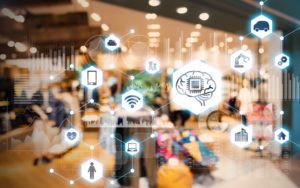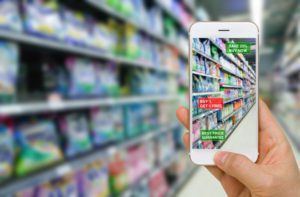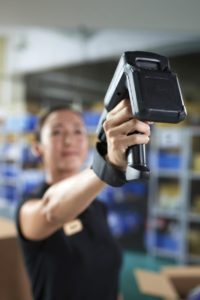
Profit margin: the ever-present metric looming over retailers everywhere. It’s a constant battle to shave off costs and increase revenue to keep that number ever-growing without sacrificing quality and customer service. For a sustainable plan on improving your bottom line, look for solutions that allow you to operate more efficiently. Here are four different ways for retailers to implement retail technology into their business that will do just that:
1. Use Artificial Intelligence (AI) to Analyze Data Across Channels
Artificial Intelligence (AI) is influencing every area of the retail industry, from relationship management with chatbots to improving the customer experience with virtual and augmented reality. A recent study by Accenture shows that AI is expected to give companies a 38% boost in profitability by 2035. To capitalize on this growing technology trend present-day, businesses should look at the different ways they can implement AI into their retail vertical.

AI can help retailers build a data model based on past purchase history and channel shopping preferences to hyper-target shoppers with promotions and deals. Artificial intelligence detects underlying patterns in shopper behavior to track how, when, and what specific products are bought- and by who. This information helps sort and group shoppers to create more targeted ad campaigns. More personalized campaigns not only reduce the cost to convert a sale, but also improve your retail profit margins by giving you a much greater ROI.
2. Leverage Big Data to Improve Inventory Management
For retailers today, big data is a total game changer. If used correctly, big data can reap large benefits for retailers by allowing companies to uncover and act upon meaningful shopper and operational insights.
To start leveraging this data, a good place to start is with your inventory. Make data your friend by looking for seasonal trends, items that are slow moving, and ones that keep selling out. After these figures are recognized, retailers can work on improving sales velocity to avoid overstocks and shortages.
Additionally, implementing a RFID solution can significantly improve your internal inventory operations. Item-level RFID tagging helps to increase the accuracy of your inventory and provides greater visibility into your items, helping retailers better understand what’s in stock and what needs replenished. The automation and decreased labor required results in lower costs overall and a higher retail profit margin. 
3. Use IoT to Enhance Performance
According to TotalRetail, the expansion of IoT (Internet of Things) technology in retail is expected to reach $35.64 billion in 2020. Its ability to enhance customer experiences, reduce costs, drive growth, and improve overall performance in retail environments is undeniable.
For retailers, this is especially useful when it comes to supply chain management. IoT can be leveraged within tracking systems that report data such as location, temperature, humidity, shock, or other factors that can affect your stock. This helps you keep accountability and determine whether or not materials were handled and delivered properly. More visibility into and control over your supply chain allows you to eliminate costly errors and losses, boosting your overall bottom line.
IoT isn’t just used in supply chain management, however. Cameras, motion detectors, facial recognition software and more can all be leveraged to help optimize the in-store experience for your customers. Armed with data from these systems, retail employees can better assist customers. These systems can recognize signs that customers may need help, like when they have been browsing for too long. With this, customers are never left waiting, and can be served quickly.
Personalized offers can also be implemented with IoT. RFID, sensors, and beacons can interact and provide more data. This allows for more personalized promotions that help increase customer loyalty, improve the experience, and even directly boost sales.
4. Go Mobile to Boost Sales Numbers
According to a recent survey by Zebra Technologies, nearly 60% of retailers plan to increase their spend on handheld mobile computers by more than six percent. Mobile devices continue to take over the industry because of their direct influence on customer experience and retail profit margin.
Arming your employees with mobile devices allows them to assist and checkout customers from anywhere in the store. With mobile devices, staff can look up items in the stockroom, order a different size for a customer online, or process a payment all from the palm of their hand. The right retail technology will speed up operations, yield more sales, and make your shoppers happier– which all directly affect your retail profit margin.
Work Smarter, Not Harder
When looking at ways to improve the profit margin of your business, know where to devote your efforts. Recognize when you can achieve more not by working harder, but by leveraging technology to improve the effectiveness of the work you already put in. Retail technology gives endless opportunities for retailers to streamline their operations, which ultimately improves your bottom line. For more information on how to find the right technology that will optimize your retail business, contact Mainstreet today.